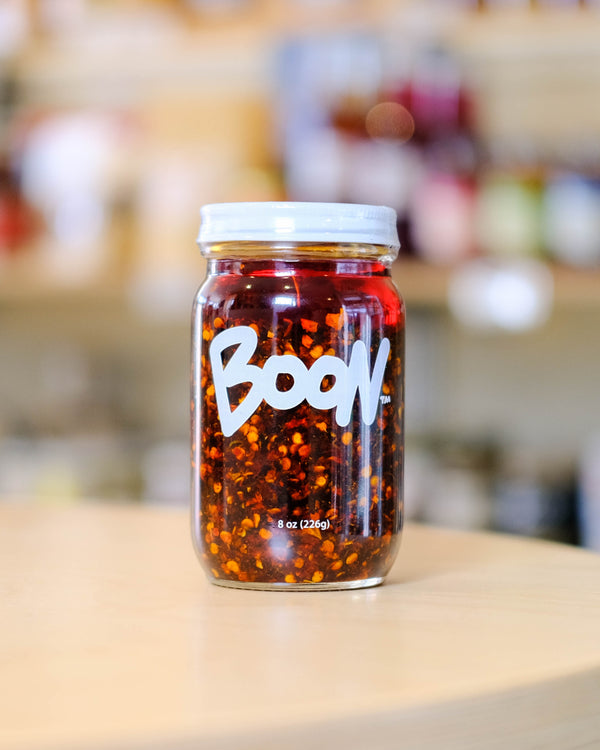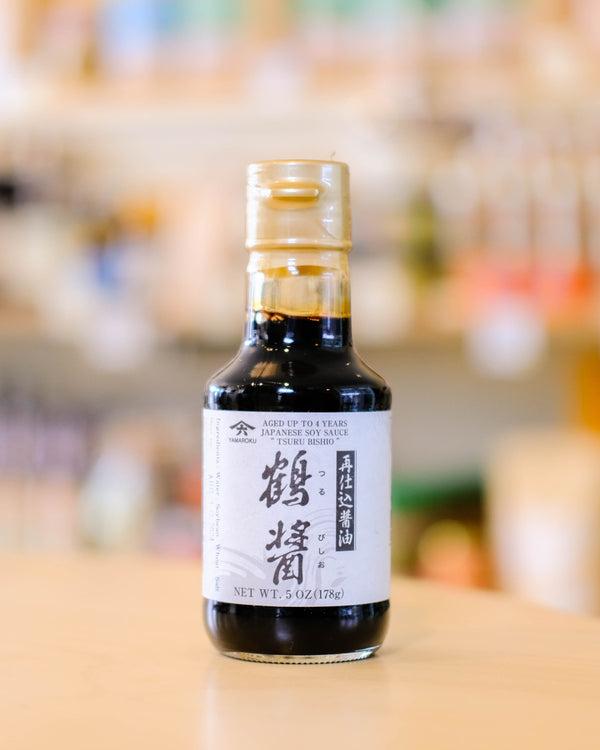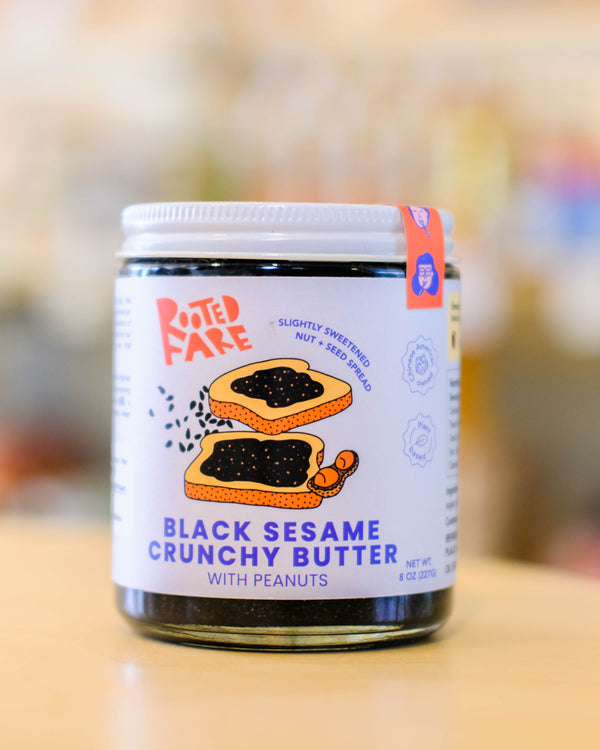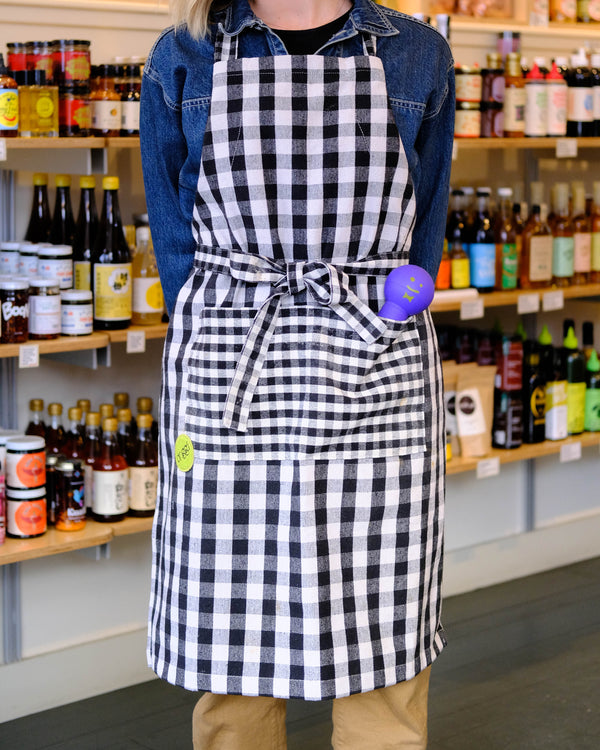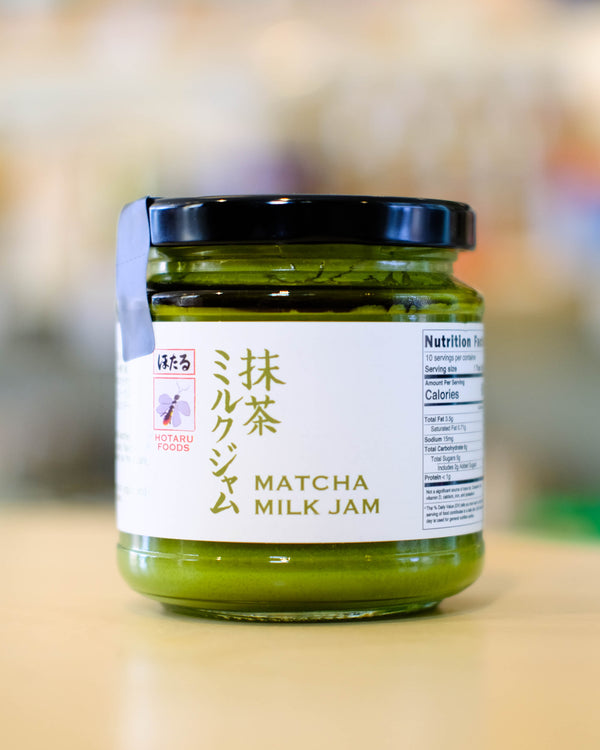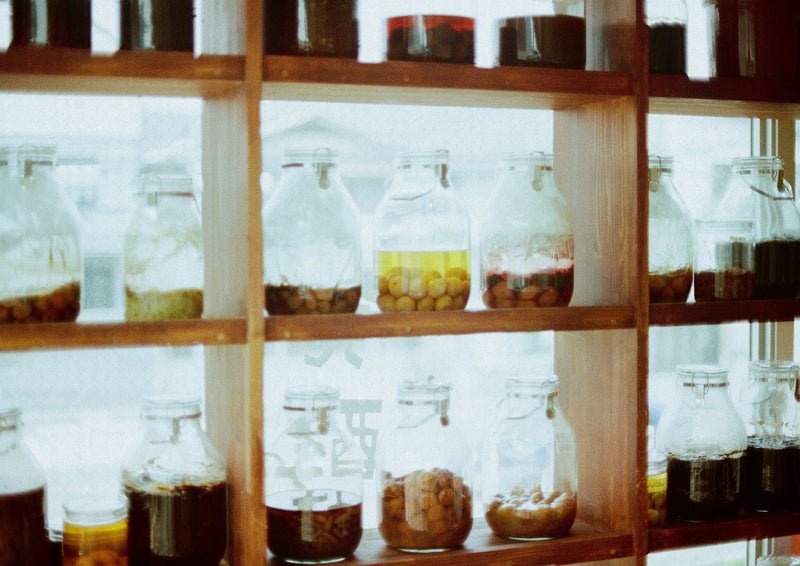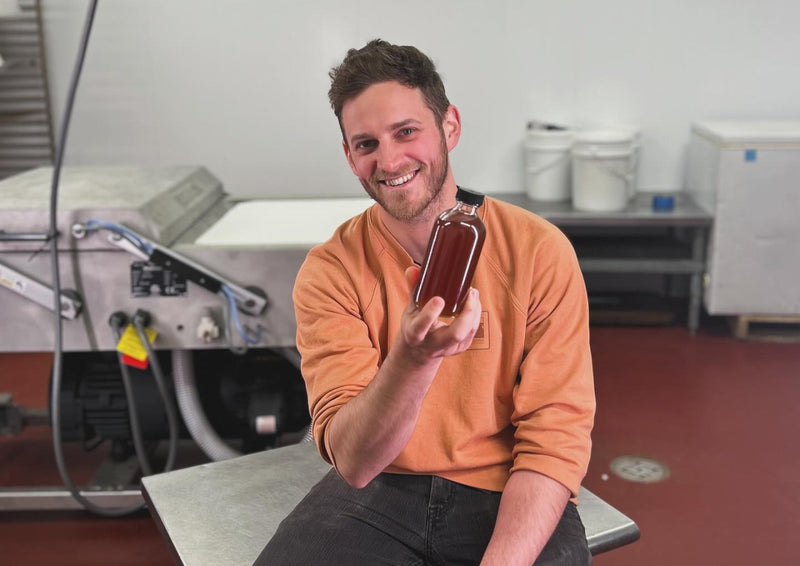On a bright and chilly morning in early December, I found myself wandering through the nondescript streets of Greenpoint, wondering if I was headed in the right direction. Following my local friends blindly, I furrowed my eyebrows as we passed an auto body shop, heading closer to the underbelly of the Pulaski Bridge. When we turned onto a side street lined by several quiet, industrial looking buildings, I concluded we truly might be lost. It was then that the warm, neon glow of Hana Makgeolli’s brand sign- a circle encasing a strong, nurturing looking woman- shone to me through a glass storefront like a beacon.
I had long been curious to know more about Hana Makgeolli’s Owner and Founder, Alice Jun, and the conception of her traditional alcohols after she hosted a makgeolli (pronounced mahk-GUHL-lee, a type of Korean rice wine) tasting event at Onggi in May 2024. Our market has stocked Hana’s bright and refreshing rice wines for some time, gaining significant popularity amongst our community members, and frankly, taking up permanent residency on my bartop.
Ducking my head out of the cold and into Hana Makgeolli’s brewery and tasting room, the goal was to talk with Alice about all things Korean rice wine for about an hour. Instead, I found myself leaving the brewery as the sun went down. Finding a cozy home amongst the concrete, I spent the entire afternoon trying different kinds of Korean alcohol (known as sool), chatting with Alice and her team, and eating copious amounts of delicious Korean comfort food. It was the best afternoon I’d spent in the city yet.
Those in the industry might recognize Alice for the triple Aries genius that she is. With a background in business, media marketing, consulting, and years of homebrewing experimentation, Alice seized the national beverage market at a critical time, bringing traditional sool- and namely, makgeolli- successfully into the hands of US consumers. A feat that previous domestic sool brewers had tried with little gain. With her warm smile, caring nature, and quiet iron will, it comes as no surprise to those who have met her that Alice and her team have made Hana Makgeolli one of the most reputable sources for sool in the United States- leading the growth of sool brewing across the country and beyond.
Now, Hana Makgeolli is expanding their innovation once again; edging into international markets and concocting new brews like Maq8, all while preserving the authenticity of a drink more than two thousand years old and carrying its spirit into the future.
 Bottles of fermented sool, alongside a traditional onggi, welcome visitors to the Hana Makgeolli tasting room.
Bottles of fermented sool, alongside a traditional onggi, welcome visitors to the Hana Makgeolli tasting room.
Alli: We hosted Hana Makgeolli at Onggi in May of 2024 for a tasting and demonstration, but for those who weren’t able to attend and are interested in getting into the world of sool and rice wine, can you tell us what makgeolli is?
Alice: So, makgeolli directly translates to ‘roughly filtered’- or you can even go as far as saying carelessly- ‘filtered thing.’ But, obviously, as we know, it’s far from careless. The conventional style that is known by most people in this market is a sweet and sodapop-y, sedimented and creamy drink. But the way we define it here [at Hana Makgeolli] is a sedimented, Korean rice wine that is fermented from rice using nuruk and is 10% ABV and below.
That is our very technical definition of makgeolli, but I think, more practically speaking, when people say makgeolli, they are actually talking about sool. It’s just that they might not know the term ‘sool’- or are not confident in using the term yet. But, makgeolli is kind of the representative drink of the entire category of Korean alcohols that have so many different types of styles within, not just makgeolli.
Alli: That’s helpful! That was my next question. Can you tell us what sool is?
Alice: Yeah, what is sool? When we talk about sool, then we start to broaden the definition of things. Again, from a technical perspective, the way we define sool is any grain based alcohol fermented with nuruk. It’s a really open ended definition on the grain front. Yes, of course, rice is what we know as Korean alcohols because they are often referred to as Korean rice wines. But, within the category of Japanese sake, for example, it’s not limited to rice. Producers have a history of using wheat, sorghum, buckwheat, and barley. And this involvement of other grains has a history of 2,000 plus years. At the time, it really wasn’t about what makgeolli should be made of, it was also about what we had available. That’s why we leave that part open ended.
The part where we are a little bit more prescriptive is around the idea of being fermented with nuruk. We see it as the key differentiating factor for Korean alcohols versus Japanese, Thai, or Chinese rice wines. On that note, all the other styles of rice wines from any other country or culture, those also have distinct fermentation starters and methodologies too, it’s not just unique to the Korean category.
Within the Korean category, we are talking about a starter called nuruk and we are prescriptive about it because it’s nuruk that makes the flavors, textures, and qualities of makgeolli that we love; nuruk is what enabled that in the fermentation thousands of years ago. It is a sufficient fermentation starter to complete the creation of the rice wine making process without the addition of yeast, inoculates, enzymes, additives, etcetera that is the majority of the market today.
That’s not to say those products are bad, but it is not those enzymes, it is not those yeasts, it is not the use of raw wheat that is representative of the makgeolli that we all know and love. We are actually talking about the nostalgic qualities of brews that were made with nuruk from the past. And it’s being mimicked in conventional products using other ingredients, but nuruk is at the heart of it.
Alli: So when talking about Hana Makgeolli’s different products- you have yakju, makgeolli, etcetera- I know that they are based on different sediment amounts and polishing. Would you refer to these types of alcohol on the whole as sool?
Alice: We should be called Hana Sool Company or something. [laughs] Or, you know, Hana Brewery, or whatever it is. Hana Makgeolli is a little bit misleading. Probably because I made this name in 2016 when I was a very passionate home brewer. I was aware that it wasn’t the correct representation of what I wanted to do, but that’s the word people know.
Alli: Right. I think it brings good recognition to a word that is just now starting to get a foothold in America, or grow in awareness amongst communities that did not grow up with it. I wanted to make sure I don’t phrase my questions incorrectly! [laughs]
Alice: I know. Makgeolli is one part of the sool category in the same way that soju is one part of the sool category. And, you know, within one category there are many, many different styles.
Alli: So, sool is the broad, encompassing term?
Alice: Exactly.
Alli: Lovely, thank you for sharing. You started to touch on it a bit already when talking about nuruk, can you share how makgeolli is different from sake?
Alice: On the note of rice polishing, actually, there is little to no practice of polishing outside of the technical 8%, 10%, maybe 12% that it takes to get the brown rice hull off. Outside of that, we don’t see a lot of polishing in makgeolli brewing and sool brewing in general. I think there are a few reasons for that.
One, Korea wasn’t a country that could afford to polish away rice. It wasn’t only viewed as wasteful; you were throwing away food- precious food- for a country that was under famine for many, many decades. The use of rice in our sool was so special and we wanted to keep it whole. From a chemistry or technical perspective, it’s also the thing that enables the flavors that we love and adore in makgeolli. Mainly, I’m talking about the esters.
So, in sake production, the goal is purity or singularity. That’s why it’s important to polish away the fats and proteins that may be on the outer hulls or the outer layers of the rice outside the inner starch core. Because, if you’re just fermenting pure starch, the more clear your flavor is, right? But, in sool brewing, those fats and proteins are wanted. We want to be able to take those lipids and take those amino acids and convert them into fruity, tropical flavor profiles. Like, if you taste takju on your left. [points to the flight of sool sitting in front of us] This is the one Onggi is most familiar with, and probably what you’ve drunk the most.
Alli: Probably, yes. [laughs]
Alice: It has that ‘overripe melon guts’ quality that people love about makgeolli. And it is created through the fermentation of those fats and proteins. Without them, we couldn’t make these flavors either. So that is also one important factor around rice polishing.
Outside of that, nuruk is different, not just by name, but by composition. So, koji and yeast perform the same functions as nuruk, but from the sake perspective, you’re talking about monocultures that are selected and grown to be a monoculture and then applied to the brew. Versus, in sool brewing, you are relying on a polyculture- instead of just aspergillus oryzae, you have many wild fungi- instead of just some kind of saccharomyces strain that’s pre-approved by the government, [laughs] we have many, many different types of yeast.
Alli: So, sool is more of a wild ferment?
Alice: Exactly. And that’s, I think, the most important difference between sake and sool; it’s what ultimately makes it taste different to us.
Alli: Yeah, the koji flavor in sake is very distinct and different from the flavor you get from makgeolli or whichever type of sool you are trying.
Alice: Exactly. But, the koji is not such a clear and crisp line anymore. A lot of makgeolli today is brewed with koji and you can taste it, actually.
Alli: Oh, that’s so interesting!
Alice: Yeah!
 Alice Jun, Founder and Owner, and Benny Kim, General Manager, behind the bar in Hana Makgeolli’s tasting room.
Alice Jun, Founder and Owner, and Benny Kim, General Manager, behind the bar in Hana Makgeolli’s tasting room.
Alli: How did Hana Makgeolli start? I’ve heard a little bit about it, but I think it’s a really interesting story, so I would love it if you could share more.
Alice: I started brewing as a kid with my dad. I learned how to do it like how you learn how to cook: very casually, without many rules, without measurement. I didn’t really think much of it. But, as I grew up and moved over to New York for college- I’m from California originally- I found myself homesick; I wanted to brew. Also I was a freshman… you know how it is. [laughs]
So, I brewed in my dorm. And that led to another brew, which led to another brew. And it was all without understanding any of the stuff around nuruk that I know now. I didn’t even know what yeast was, I had never even verbalized the word. It was all muscle memory, observation, a sense of smell and taste. But that, while a skill I really appreciate now, is also imperfect and leads to a lot of mistakes. And then, that’s when the fermentation bug gets you- when you mess up. You’re like, “Okay, one more time,” right? [laughs] “If I just change this one little thing, it’ll be fine!”
Alli: We at Onggi understand that very well! [laughs]
Alice: And that’s how it happened. So, one-gallon brews turned into five-gallon brews, turned into four or five five-gallon brews at the same time, turned into getting bottlenecked in my apartment fridge because everything was makgeolli and then needing to get it out. Sharing it with people, doing parties, doing events, doing classes. Going to- what was that festival I met Marcus at? The Fermentation Meetup? In some random warehouse or school in Bushwick. [laughs] Things like this; one thing leads to another. I met my business partner and we found this space, COVID happened, we found our rice. I’m going to cry. [laughs]
It was all kind of a slow burn. Because in part we had to be cautious- it was scary, it was so risky at the time. Even before COVID, the three makgeolli breweries that existed in the US had dissolved. All for different reasons. Not necessarily because makgeolli wasn’t viable, but there were other issues, and maybe a timing issue too.
Alli: That’s intimidating enough to start, but especially to have a pandemic tacked on top of that.
Alice: But the silver lining- as you guys know with Onggi too- when you’re talking about fermentation, you can’t avoid being technical. Actually, people crave that information, but people didn’t have time before the pandemic. By starting in the pandemic, we had time to actually have those conversations with new customers, with people trying makgeolli for the first time, with people who haven’t had this kind of makgeolli in decades. You know, things like this. And that was the silver lining- there was a bit more capacity to listen to this kind of story.
Alli: That information is so necessary if you haven’t had the knowledge of specific fermentations passed down to you over time. Trying to relearn that knowledge as it is lost- you need the time and space to sit down, experiment, and actually really absorb it. We’re so happy that the chips fell the way they did so that Hana Makgeolli is here and exists! I am curious, though, how did Hana Makgeolli get its name?
Alice: Hana is my name!
Alli: Oh!
Alice: No one knows that.
Alli: [laughs] Is it okay if we share that?
Alice: Yeah! No one knows that, but people ask all of the time. I’m like, “Oh, it’s my name.” But, no one calls me that. My parents call me that. My brother, usually he’s like, “Jun Hana!” whenever he’s mad at me. [laughs] That’s really the context in which I hear it.
It’s not a name a lot of people know, but starting Hana Makgeolli in 2016, 2017, I didn’t know what to name it. I thought that it should be a Korean name because we are making traditional alcohols, but then, every Korean name I could come up with felt weird coming out of my mouth. I can speak some Korean, but it’s not my language, right? But then, to do it entirely in English felt inauthentic too. So I just chose my name! [laughs] It was the easiest thing!
Alli: Well, it’s true, your name is authentic to you!
Alice: It was the easiest.
Alli: That’s so interesting, I definitely didn’t know that. I’m going to quiz the Onggi owners when I get back, I’m not sure they know that! [laughs] We started to talk a little bit about the flavors of makgeolli evolving and people’s recognition of those changing over time. Can you share a little bit about the history or significance of sool in Korea?
Alice: So, there’s a documented history of 2,000 plus years, but archeological history that people were brewing for much longer than that. Alcohol has cultural, social, and religious significance in most societies. Particularly in Korean culture with the pervasiveness of Confucianism and ceremony, and paying respects to your elders or spirits- using sool was a big part; it made it a necessity. It wasn’t just a joy, it was a necessity. And brewing artfully was also a necessity, because you wanted to please the people you offered it to, right? Not just the literal mouths.
So that is the beginning of the origins of sool. I’m not exactly the best historian or subject matter expert on the topic, but the art of making sool is also the art of fermentation in Korea. In addition to the significance of literally the drink, the act of fermentation was a means of preservation in a country that was not necessarily abundant throughout half of the year and that was also a big part of it too. So- in addition to needing to store rice- come the rice harvest, if there was an abundance, you could make sool. And you kind of had to, or at least you should.
Sool has many meanings in Korean culture. Between the Goguryeo Dynasty when the first documents of sool were, to the Joseon Dynasty, we started seeing prolific advancement of the sool category. Like us homebrewers today, homebrewers then were also curious and driven. When that happens, there is more experimentation, more creativity and a forming of a methodology within a certain home, or a certain town, or a certain province. And then [that leads to the creation of] regional styles.
Really, the Joseon Dynasty is what historians view as the pinnacle of the sool renaissance in Korea. So many different producers, so many regional and provincial breweries. Sool was an important part of everyday life.
In addition to that, there was also hierarchical structure to sool. So, the yakju that you drink first was something that was typically brewed in these onggi and then whenever the brewers wanted to take from it, instead of racking- because the rice it sinks, but you won’t get the best yield- they would put a yongsu, or a little basket, directly into the middle of the mash and then leave it overnight for a few days. Then, inside, because the basket acted as a strainer, would be the clear sool. That would be taken and given to the noblemen, the yangbans, the people that were higher socioeconomic class and the sedimented wines would be given to the farmers, the laborers, right? That’s also where makgeolli gets its reputation as a farmer’s drink.
So, that’s the extent of my knowledge.
Alli: [laughs] I mean, that’s more than I think most people know about it!
Alice: Social hierarchy, religious, spiritual needs, and then the importance of fermentation in domestic life and gastronomy.
Alli: That’s really cool. I know there was a prohibition with sool and home brewing during the Japanese occupation and a lot of industrialization happened during that time as well, which resulted in a lot of knowledge being lost. This also changed people’s understanding of what the flavor profiles of sool traditionally were, right?
Alice: It’s so crazy hearing someone say that back to me!
Alli: Oh, really? [laughs]
Alice: That’s never happened to me before! It’s really cool!
Alli: I think it’s really interesting!
Alice: It is interesting! That’s what I’ve been saying for like ten years and it’s crazy that someone is saying it back to me right now! Okay- anyways! [laughs]
 A customer pours the Omija Makgeolli into two cups, with a sample of a five year aged takju sitting nearby in Hana Makgeolli’s tasting room.
A customer pours the Omija Makgeolli into two cups, with a sample of a five year aged takju sitting nearby in Hana Makgeolli’s tasting room.
Alli: I’m curious to know how sool’s significance has evolved since the post war period, both in Korea, but also generally. Because we know a lot of globalization happened from there.
Alice: Yeah, I don’t mean to be like, “Boohoo, Korea’s sool- this is why you should buy ours-” this happened to so many cultures all over the world related to food and beverage methods. I don’t want to dwell on the past, but I do think that the contemporary styles of makgeolli and soju that exist in majority volume in the market today are a little bit misleading.
Yes, there is a time and place and more pockets that are able to afford and access makgeolli that is made from tapioca starches, potato starches, and refined enzymes and yeasts, and sweetened with aspartame. Because they have this pleasant, sweet, and sodapop-y taste, and it’s only 6% [ABV], and with soju too. It’s very, very affordable, 15% to 25% ethanol petroleum, but it’s still food grade, right? [laughs] But sometimes you want that. There are deep cravings for these contemporary products. [These cravings have] set soju as the number one consumed alcohol by volume in the world since 2011- it’s crazy!
So, there is a legitimate market for it. And to say that, that is not representative of the Koreas today, it would not be true. These products are beloved and iconic. But, people don’t know how they are made.
Now, today, almost two thousand plus craft or traditional breweries have since come from the South Korean country and also a few of us- not just Hana Makgeolli anymore- that are on the US side, and then there’s a brewery in Bogota, Copenhagen, Germany. You know, there’s more and more of us that are starting to brew makgeolli outside of Korea too, that feel that there is no room in the Korean market of sool for what the original product of sool was.
And that’s what Hana Makgeolli is about: trying to carve out that space, trying to convince people that actually, fine, you can like the sweet and sodapop-y stuff, there’s nothing wrong with that, but these traditional flavors are also relevant to our palates. And by ignoring this tradition, you are wasting thousands of years, many, many generations of effort, in trying to preserve this methodology and to pass on these flavors.
These things can coexist. And there needs to be room for both. Because, frankly, some people don’t like the sweet makgeolli. And some people don’t like the conventional soju and they should have options. There’s also the aspect of Korean food and the way it’s having its moment globally right now. There are so many incredible Korean chefs choosing the best ingredients, using the highest level of technique, and putting so much care into their work. And then they have to pair it with sake. Which isn’t bad, but they want to pair it with sool. Because what other option do they have? So, it’s about making room for that too.
Alli: That’s really awesome, thank you for sharing. It’s so interesting to me how those pivotal moments in history have pushed things to evolve in a certain direction and the revitalization and innovation that comes with trying to preserve those thousands of years of experimentation. So, along the same lines, how do you think COVID has had an impact on demand for sool and its production?
Alice: I mean, overall a very positive impact, because people were drinking a lot. Like we were talking about earlier, it gave people, or at least for us, it gave us a chance to talk to people and teach people about sool when they had the capacity to do so. When you are trying to tell someone this kind of story, it just…
Alli: Goes over their head?
Alice: It’s not their fault, because they just don’t have the space for it. So, for all of these reasons it was positive. But, COVID was COVID and it was horrible overall. It didn’t come without hardship.
The way COVID affected global supply chains and politics between countries and then in turn the material cost of production. The way COVID impacted inflation and not just the cost of doing business, but the cost of enjoyment for our guests and our customers - all of that is bad. Now that the amazing growth and heyday of the alcohol industry during and post COVID is over, producers are really having to grapple with that. If someone is going to spend money on your products today, it has to be about value. It can either be bang for your buck or quality of product, but you have to fill a need at least on one end or another. So the pressure is a little bit different for new producers that are starting now.
Sometimes I wish Hana had existed under someone else and then when I started, I could have been mentored by them or used them as a benchmark. Like, how lucky would I have been if I had just started a little later after our first move or something like this? But on the other hand, I can’t imagine what it’s like to try and have this dream that I had six, seven years ago to open a brewery. In this environment? It’s impossible! We just made it before the cutoff, you know? It was like a frickin’ miracle! [laughs]
Alli: It’s fascinating and honestly leads into my next question really well. I think I read in a past interview of yours that Hana, at the time, was the only makgeolli producer in America. Has that remained the same?
Alice: No, it was at the time! Now there are seven. There’s us, New York Makgeolli that existed in Wurtsboro, New York before us. They closed and sold; they just opened up a new farm. They used to make dudukju. What’s dudukju in English? Burdock? No, it’s lance asiabell! They used to make alcohol from lance asiabell- it was like a root vegetable alcohol- and now they are back. There is Rainbrew in Seattle, there is Kooksoondang Makgeolli that has a startup in Portland, Oregon. There’s Angma soju in LA in addition to Nomi Doga makgeolli and a few others in LA. There’s Minhwa Spirits in Georgia, there’s so, so many.
Alli: So in the time since Hana Makgeolli started, there’s really been an explosion happening.
Alice: I don’t think it’s even an explosion yet!
Alli: It’s building?
Alice: Yeah, we haven’t even started. Which is insane!
Alli: Considering the context of the current state of the world and sool market, could you speak to the process of first identifying the viability for sool here in America? Recognizing, as you said, that maybe it didn’t feel like there was space for the traditional production methods in Korea?
Alice: Yeah, well, I am a triple Aries.
Alli: Oh my gosh. I am also triple fire by the way- all three signs.
Alice: Ah! Ooh la la! [laughs] Then you know what I mean, right? There was no way I was going to not [start Hana Makgeolli], if I look back on it in hindsight. But, in the beginning, even though I didn’t set out with the intention of becoming a brewery or starting a brand more commercially, I did notice certain trends. And it felt like a unique convergence.
How often does it happen that a product is truly so novel? And how often does it happen where within grape wine there’s this huge natural wine movement? In the same context and in the same markets, sake is also starting to mature and people are really starting to understand that there’s an industry. And then on top of that, craft beer, when it comes from an IPAs and sour perspective, is plateauing, and then it's moving into saisons and lambics.
How often does that all happen right at the same time between the early 2000s- maybe 2010 someone would start counting that down into 2018? All of those things were happening all at once and makgeolli is dead straight in the center from a chemistry perspective, from a fermentation perspective, and a flavor perspective.
And then on top of that, there’s Korean food. It was like chef Hooni Kim of Danji- he was kind of doing it up solo in the city representing elevated Korean food- and then all of a sudden there was Atoboy, and everything was happening right then and there.
Alli: And then you have the wave of K-dramas becoming really popular and K-pop.
Alice: They call the hallyu in Korean: the K-wave. And on top of that, consumers were becoming more health conscious.
Alli: So, it really was all of the stars aligning to create the perfect opportunity to jump off from.
Alice: You would have to be blind not to see it. And, I mean, many people were when we were raising money. A lot of people told us no. But, because of the unique convergence of trends and also because I am an Aries in all of the good ways and bad, that combination gave me conviction.
Alli: We love fire signs. Fire signs are great, they’re my kind of people. [laughs] It is very clear that sool was a niche at that point in time. And you can see since other breweries have started and they are continuing to grow here in America that it really was the proper time to move things forward.
Let’s switch gears a little bit to Hana specifically. Can you walk me through the production process here at Hana? How do you make your sool?
Alice: So, every recipe for every cuvee is different, but at a high level: we first start with organic rice. This wasn’t strategic from the onset, but we have only worked with one family for our entire production and I think that is, at this point, very special. Our guests and our customers have tried the 2019, 2020, 2021, and 2022 harvest and we’ve just started going into the 2023 harvest.
We source all of our rice from this one farm in the Sacramento Valley of California, we also source all of our nuruk (the fermentation starter) from one producer in Korea called Songhakgokja. They’re in the Jeolla-do Province- the southwestern province of Korea- and they’re an incredible nuruk producer. And then, [we use] New York City tap water, filtered for chlorine of course, but you know, New York water is amazing and makes for such good brewing water. Actually, sometimes it’s a little mineral deficient, but we don’t do these kinds of adjustments.
Outside of these ingredients, that truly is what we use at Hana Makgeolli. We are not mineralizing our water, we are not acidifying our water, we are not adding refined enzymes, we are not pitching in yeast inoculates. If we’re clarifying, we are not using clarification finding agents. When we’re finishing a wine, we obviously don’t add sulfates or any stabilizers. Sorbates are the more common stabilizer in makgeolli; we don’t use those. We are certainly not adding sugar, natural or artificial. We’re not doing any of those things; it’s truly, mainly those [previously mentioned] ingredients. Sometimes, if there is a botanical infusion of food co-ferment, those ingredients are actually used, but outside of that, that’s it when it comes to what goes into the products.
Now, when it comes to what we do with those ingredients, the creation of sool is basically the conversion of starch to sugar and sugar to alcohol. And you can do that any number of ways; you can just combine all of the ingredients and it will happen, but there’s more advanced methodologies.
With Hana Makgeolli, mainly we are looking at it from stages- so our brews are built in three to five, sometimes six stages. And that can take a week and half to three weeks to just build a ferment, like, fill a tank in its entirety.
Then, of course, it’s the fermentation time. We’re fermenting for anywhere between four to eight weeks depending on the cuvee and what we’re going for in terms of final flavor. Generally speaking, it results in a dry-to-near-dry wine that has a bright, lactic acidity that is microbially created by lactobacillus, not pitched in [lactic acid] and relatively high ABVs as well, anywhere between ten and sixteen.
Alli: Thank you for sharing, it’s such a fascinating process. Someone who attended the class you hosted at Onggi back in May had asked why Hana Makgeolli doesn’t make their own nuruk and I really, really liked your response at the time. Could you share with us again why Hana Makgeolli chooses to continue working with a nuruk producer in Korea versus making its own?
Alice: One [reason] is that we can’t make it here. We could capture, certainly, all kinds of yeast ambiently, but there is insufficient fungi in an urban environment like New York. And neither is it the fungi that we want, right? [laughs] If we’re trying to make nuruk properly and do an ambient inoculation, we need to be in rice fields and wheat fields and environments where it is naturally clean and the cultures we need are aplenty.
Secondly, it’s about supporting the nuruk producer. There’s maybe three nuruk producers that are commercial, meaning they are making nuruk in regular volume and at a consistency where brewers can rely on them to use it- there’s only a few. One of them is owned by Jinro and no one can touch that nuruk. Then, there’s Songhakgokja and there’s Guemjeongsanseong. We decided to source from them because there's a reason why there’s only three left. An industry died. And it’s actually a miracle that they’re still making it, so we want to support them.
Alli: I remember you saying that and I thought that was so important, because once that knowledge is gone, it’s gone. Hundreds of years of experimentation, practice, knowledge, and infrastructure and once that’s gone you can’t get it back. So I thought that was a really special part of Hana Makgeolli as well, that supporting those producers and centuries of knowledge are integral to not only your values here, but to the sool that you’re making as well.
Alice: Awh, thank you.
 Hana Makgeolli brewing ingredients from left to right: organic white rice, dried nuruk, organic brown rice, organic white rice.
Hana Makgeolli brewing ingredients from left to right: organic white rice, dried nuruk, organic brown rice, organic white rice.
Alli: We’ve talked about what nuruk is so far, but could you clarify what nuruk is made of?
Alice: Functionally? Okay, substrates wise, ours is made of wheat and barley, which is often the case for nuruk. Other substrates that can be used are sorghum, rice, mung bean- that’s a good one. In terms of microbial composition: lots of different types of aspergillus, but also many different types of saccharifying fungi. Ours is dominant in rhizopus. From the yeast perspective, of course some strains of saccharomyces, but oftentimes, our nuruk are wickerhamomyces dominant, also known as pichia. It’s that yeast that also creates acetone; or it can create acetone if it’s given the right conditions. Then, there’s many varieties of lactobacillus. And then, who knows what else, honestly. [laughs] Thousands of bacteria!
Oftentimes, even in beer brewing and in sake production- less so in sake production- the malting step (the saccharification) is a separate step from the alcohol conversion. They pitch the yeast in later or they expose the brew to yeast later. But in sool brewing, because nuruk is a polyculture and has all of these cultures in one, they are introduced to the ferment from day one, from the beginning. So, yes, sake production is parallel or diastatic fermentation, but it's only after which point you pitch the yeast. In sool brewing, the ferment is parallel from day one and on top of that, because of the wild nature of the cultures, they are very resilient and they are very productive.
Oftentimes, nuruk will have a higher saccharification power than koji will. We can break down more heavier, complex starches with nuruk. At Matchbook Brewing, every once in a while, Leslie will call me and be like, “These pumpkins are not breaking down with the koji!” And we’ll drive the nuruk out there and help them out. It's a very, very powerful culture.
Alli: Wow! I know that a lot of the sool here at Hana Makgeolli also includes seasonal rotations with botanicals. For example, I love the Omija Makgeolli- it’s one of my favorites! How do you select the botanicals that you’re using?
Alice: We try as much as possible to do traditional Korean botanicals; omija is a really popular botanical berry that’s used in sool on the fermented and the distilled side. Hwaju [one of Hana Makgeolli’s brews] has chrysanthemums, which is also a very traditional botanical where you’d make gukhwaju, right? But there are some botanicals that we want to do that we can’t, because they are not FDA approved. [laughs] We are limited in some senses to what’s approved on that list. So, that’s another consideration to be real with you. And then, it’s about what we have access to. Or what my team wants to make. I know it’s maybe oversimplified, but sometimes it’s not necessarily with a dramatic intention. We’re just like, “Hmm, what would marshmallow root be like?” [laughs] You know? Things like this.
Alli: Which is fun! That’s a part of the experimentation and innovation that makes something that has existed for thousands of years remain relevant, especially in the place that it’s based in.
Alice: Agreed, agreed.
Alli: That’s awesome. I know there is a history of using botanicals with sool overtime.
Alice: Yeah, you know, in every culture, alcohol is an effective solvent for botanical medicines. It is often used for medicinal purposes in societies around the world. Korean culture is no exception to that. It’s also about preservation, right? It’s not necessarily for medicinal purposes, but you just have a shit ton of orange blossoms and you have to put them in something or they’re just going to decompose and die- and they’re too beautiful to let go. You want to preserve it. So, there’s that too. That element of play and creativity isn’t just in the modern context. It is a need- a necessity- sometimes.
Alli: It’s served a purpose for thousands of years.
Alice: Exactly.
Alli: I love that. We’ve talked a lot about traditional production and this being something that in Korea’s postwar period has changed significantly for sool. What does traditional production mean to you and why is it important that you carry forward sool production at Hana Makgeolli?
Alice: For us the way we define it is nuruk, first and foremost. Without nuruk, as I was mentioning before, the sool that we know wouldn’t exist, even the conventional stuff. It’s really important to us to try to show people the power of nuruk, the beauty of nuruk. The versatility of it. And from a commercial perspective, [it’s important to] try to make a point that it’s sufficient, that you don’t need all these other things.
From a finishing perspective, I think it’s this continued commitment to fermenting to dryness. Not adding sugars, not adding additives. It started off, admittedly also, because I don’t know how to do those things, I wasn’t taught. But I also don’t want to know. [laughs] I want to enjoy what I make, I want my team to enjoy making it too. And those kinds of things- this might be childish- but they’re a little scary.
We are trying to also give people a sool that they can enjoy authentically. Not necessarily from a ceremony perspective or even from a foodpairing perspective. We even cocktail with our sool so we're not exactly purist in terms of our service of sool; we do give it to our guests in many different formats in our tasting room. But I want people to enjoy the spirit of it authentically. There’s something about makgeolli that’s very, very jolly, right? [laughs] Communal, jolly. Like, [smacks her knee twice] that kind of funny. It’s these really vivacious, warm moments at the table that make makgeolli so fun. I do really believe that certain alcohols create different types of drunk and makgeolli is just so fun. Like, warm, full belly kind of fun. We try to give people that experience through our wines as well. That’s why we do the high ABVs. [laughs]
 Scallion pancake is served alongside cups of the Omija Makgeolli in Hana Makgeolli’s tasting room.
Scallion pancake is served alongside cups of the Omija Makgeolli in Hana Makgeolli’s tasting room.
Alli: That’s lovely, we love that! [laughs] So, what’s new at Hana Makgeolli?
Alice: We have a very exciting new launch coming out- it was literally announced yesterday- it’s launching next week [at the time of this interview]. It’s called Maq8. This is the first time I’m telling anyone about it!
Alli: Ooh! So exciting!
Alice: It’s a canned makgeolli product. It’s in these little short, eight ounce, stubby cans. It’s the same Hana Makgeolli branding, but she looks a little different. It’s a bit more cute. We are giving people what they wanted in terms of the sweetness. But, in true Hana Makgeolli fashion, it’s residual sugar. No added sugars. In true Hana Makgeolli fashion, it’s still made with the same organic rice from Polit Farms.
We did use monocultures. But they’re monocultures that are derived from our nuruk. They incubated and were grown by Al from East Coast Labs- he’s this wonderful yeast banker that supports all the wild breweries here in New York. It’s like this really simple, sweet, sodapop-y kind of makgeolli, but not at all like Kooksoondang, or Makku, or Wolmae, it still has a little bit of microbially created lactic acidity. We know that the brettanomyces created from the nuruk also made it in there as well just from testing. So, it’s still a representation of our culture- not Korean culture, but Hana Makgeolli’s culture, our microbial culture. But it’s experimental.
Do you want to try it?
Alli: I would love to! Oh my gosh, I’m actually honored. I’m so excited!
Alice: We did force the carbonation. We don’t get it with primary fermentation. I'm scared!
Alli: Oh, that’s so fun! It’s so light!
Alice: It’s so light! And it’s simple. Simple is a bad word for it, but do you know what I mean?
Alli: Yeah, it’s easy! It’s not overly complicated.
Alice: It’s really easy. 8% ABV…
Alli: I can see people drinking this outside in the park on a sunny day.
Alice: It’s so good with food! Because of the acidity.
Alli: I bet! This would probably pair well with a lot of things too. The whole Onggi team is going to be so jealous [that I’m sampling this], I’m so excited to tell them about this!
Alice: And it’s affordable. What this year taught us is that it’s not that people aren’t willing [to buy sool], they want to, but they just can’t. And that’s fine. It’s also our job to meet people where they are and it also gave us an opportunity to engineer something new.
Alli: I love the mouth feel. It’s creamy!
Alice: We’re calling this first style, ‘Silkysonic.’ [shows the can]
Alli: It’s so cute! I like that it almost looks retro! I love the size of the can too, this is really fun.
Alice: You know the little Asian cans that have the fruit inside of them?
Alli: I love that! It has a homey, retro, nostalgic feel to it. Something fun that you can take to go meet friends with food, dinner, lunch, whatever. It feels very social.
Alice: As a bartender you could just pop one open for a customer. I think it’s going to be a great hiking brew.
Alli: She’s so cute! Silkysonic, I love the name.
Alice: And she does look kind of Baymax-y, Michelin Man-y. I think there is something comforting about that. We’re calling it Maq8, not just because we’re tired of people calling it, ‘mak-ji-oli.’
Alli: [laughs]
Alice: We’re not Italian. [laughs] But also, it’s to represent mach speeds- like you can drink it on a rocket ship- on the go! We called it a mini makgeolli. There’s some improvements to be made- with the wine too. I have all of these ideas.
Also, we want to use this as a way for us to really show off our unconventional side. I want to make a stout version in the future. I want to burn rice and make a nurungji flavor. And I don’t want to do any of these things with extracts. In our true fashion, I want to actually make it and invent new recipes. I think it’s going to be a very fun challenge.
Alli: The whole Onggi team is going to freak out, this is so exciting. And that’s such an important part of preservation too: that sool continues to live on and change and grow in so many different ways.
Alice: Yeah, exactly. I will bring a few cases up to Onggi and we can go surfing!
Alli: Oh my gosh, yes, that sounds amazing! Where do you hope to see Hana Makgeolli and sool in general- both literally and figuratively- over the next few years?
Alice: I would really like to see- not just Hana Makgeolli, but obviously all kinds of producers- truly get global. We are working so hard to get our products out there internationally and introduce this style of Korean rice wine to people because in the same way that people in the US did not expect this dry, slightly acidic, strong flavor of makgeolli, I think it’s something that’s relevant to our palates and is not just limited to the North American, US market.
Secondly, I kind of wish Hana could live beyond me. I’m starting to try to imagine that future, you know? There’s so much work that would need to be done to actually get us to that point, but I would like Hana Makgeolli to be a reliable resource for people to learn about sool, to try good quality sool, for many, many decades to come. That’s my ultimate vision. I have no idea how that’s going to happen, but I’m going to try my best! [laughs]
Alli: The triple Aries will come out! [laughs] Thank you so much for talking with me, Alice, this has been lovely!
Alice: Thank you, Alli!
You can find Hana Makgeolli’s sool in Onggi’s market, visiting the Hana Makgeolli tasting room and brewery in Brooklyn, NYC, or order through Hana Makgeolli’s website here.
 A look at the warm, inviting ambiance of Hana Makgeolli’s tasting room.
A look at the warm, inviting ambiance of Hana Makgeolli’s tasting room.

